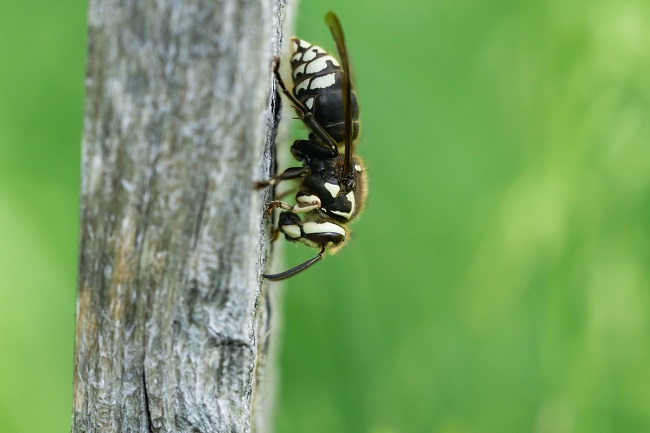
Bald-faced hornets are a common sight in many parts of the United States, including Raleigh, North Carolina. While these hornets can play an important role in pollination and controlling other insect populations, they can also pose a serious threat to humans, especially if provoked or disturbed.
In particular, their stingers can be a major source of pain and discomfort for those who come into contact with them. In this post, we’ll take a closer look at the bald-faced hornet stinger, including what it looks like, how it works, and what you can do to protect yourself from its painful effects.
What is a Bald-Faced Hornet?
Before we dive into the specifics of the bald-faced hornet stinger, let’s first take a quick look at bald-faced hornets and what makes them unique. Bald-faced hornets are a type of social wasp located throughout the United States and Canada and are a common sight for many North Carolina residents.
They are named for their mostly black bodies, with white or ivory markings on their faces and thoraxes. Bald-faced hornets typically build their nests in trees, shrubs, or other elevated locations and are known for their aggressive defense of their nests.
While bald-faced hornets are generally not considered as dangerous as other stinging insects like bees or yellow jackets, their stingers can still pack a painful punch. If you’re stung by a bald-faced hornet, it’s important to know what to expect and the steps you can take to minimize the pain and discomfort.
What Does a Bald-Faced Hornet Stinger Look Like?
The bald-faced hornet stinger is a specialized organ at the end of the hornet’s abdomen. The stinger is about 1/4 inch long and has a distinctive black coloration. Unlike the smooth, barbless stingers of honeybees, the stingers of bald-faced hornets are barbed and can be used to sting potential threats repeatedly.
In addition to the stinger itself, bald-faced hornets also possess venom sacs just above the stinger. When a hornet stings, it injects venom from these sacs into its target, which can cause pain, swelling, and other unpleasant symptoms.
When a bald-faced hornet stings, it uses its powerful mandibles to grasp onto the victim’s skin while simultaneously pushing its stinger into the target. As the stinger punctures the skin, the barbs on the stinger anchor it in place while the venom sacs pump venom into the wound..
What Are the Symptoms of a Bald-Faced Hornet Sting?
The symptoms of a bald-faced hornet sting can vary depending on several factors, including the individual’s sensitivity to the venom, the number of stings, and the location of the stings on the body. Some common symptoms of bald-faced hornet stings include:
- Pain and discomfort at the site of the sting
- Swelling and redness around the sting site
- Itching and irritation
- Hives or welts
- Nasua or vomiting (in severe cases)
If you are stung by a bald-faced hornet, you can take a few steps to reduce the symptoms.
Bald-faced hornets do not leave their stingers in the skin like honey bees do, but it is still important to remove the stinger if it is visible. You can do this by gently scraping the stinger out with a credit card or a similar object.
After any sting, you should cleanse the area to protect against infection. Wash the wound with an antibacterial soap and pat it dry.
Applying a cold compress to the sting can also help reduce swelling and pain. You can use a cold pack or a bag of ice wrapped in a towel on the sting; however, avoid leaving the chilly object on your skin for too long.
If you’re still experiencing mild discomfort, over-the-counter pain relievers can help reduce pain and swelling. However, we suggest contacting your primary care provider for any lingering symptoms that cause concern.
In some cases, a bald-faced hornet stinger can cause a severe allergic reaction known as anaphylaxis. Symptoms of anaphylaxis include difficulty breathing, swelling of the face or throat, rapid heartbeat, dizziness, and loss of consciousness. If you experience these symptoms after being stung by a bald-faced hornet, seek immediate medical attention!
Why You Need Pest Control for Bald-faced Hornets
Dealing with bald-faced hornets can be a challenging and even dangerous task. While some homeowners may attempt to tackle a bald-faced hornet infestation on their own, there are many reasons why trusting a pest control agency is the best course of action.
Firstly, pest control agencies have the experience and expertise to safely and effectively remove bald-faced hornet nests. While DIY methods may seem like a cost-effective solution, they can often result in ineffective or incomplete removal of the nest. This can leave the homeowner at risk of being stung and potentially exacerbating the problem.
Secondly, pest control agencies have access to specialized equipment and treatments unavailable to the general public.
For example, professional pest control technicians may use dust or aerosol treatments that penetrate the entire nest and kill off the entire colony. Plus, agencies have access to protective gear to keep technicians safe during removal.
Trusting Innovative Pest Solutions for bald-faced hornet problems can provide peace of mind for homeowners. Dealing with a hornet infestation can be stressful and anxiety-inducing, especially if a household member has a severe allergy to hornet stings.
By relying on our experienced technicians, you can rest assured that the problem will be resolved quickly and effectively. Contact us today to protect yourself and your family against dangerous bald-faced hornet stings in Raleigh!





